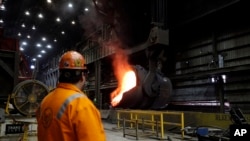U.S. manufacturing activity surged in June amid signs a strong economy and import tariffs were causing bottlenecks in the supply chain, resulting in factories taking longer to deliver goods to customers.
Other data on Monday showed construction spending increasing solidly in May though investment in April was not as robust as initially thought. The reports reinforced views the economy was firing on all cylinders after growth slowed early in the year.
"It will take a lot to derail the U.S. economy because of the sugar high it's on from the fiscal stimulus, but a developing trade war between the U.S. and its trading partners is a mounting threat," said Ryan Sweet, a senior economist at Moody's Analytics in West Chester, Pennsylvania.
The Institute for Supply Management (ISM) said its index of national factory activity jumped to a reading of 60.2 last month from 58.7 in May. A reading above 50 in the ISM index indicates an expansion in manufacturing, which accounts for about 12 percent of the U.S. economy.
The ISM noted that demand remained "robust, but the nation's employment resources and supply chains continue to struggle." It said manufacturers were "overwhelmingly" concerned about the impact of tariffs imposed by the Trump administration on a range of imported goods including steel and aluminum.
President Donald Trump's "America First" trade policy has left the United States embroiled in tit-for-tat tariffs with its major trade partners, including China, Canada, Mexico and the European Union. Trump claims that the United States is being taken advantage of by its trade partners.
Analysts fear the tariffs could disrupt supply chains, undercut business investment and potentially wipe out the fiscal stimulus from a $1.5 trillion tax cut package.
The ISM's supplier deliveries sub-index soared 6.2 points to 68.2 last month, the highest level since May 2004 and accounting for the bulk of the increase in the ISM index.
A lengthening in suppliers' delivery time is normally associated with increased activity, which is a positive contribution to the ISM index.
Manufacturers of electrical equipment, appliances and components said "U.S. tariff policy and lack of predictability, along with (the) threat of trade wars" was causing "general business instability" and was a "drag on growth for investments."
One manufacturer in the food, beverage and tobacco products industry said it was preparing to shift production "for China market from the U.S. to our Canadian plant to avoid higher tariffs."
It would join a growing number of companies, including Harley-Davidson, which last week said it would move production of motorcycles exported to the European Union from the United States.
The ISM survey's new orders index slipped as did the measure of factory employment. Machinery manufacturers reported difficulties finding qualified workers, and several industries complained about trucking challenges last month.
While the prices paid index also fell in June, that was probably because of a decline in crude oil prices. Manufacturers continued to report surging input costs, with furniture makers describing transportation costs as "going through the roof."
The dollar was trading higher against a basket of currencies on the escalating trade tensions. Prices for longer-dated U.S. Treasuries rose while stocks on Wall Street fell.
Construction spending rises
In a separate report on Monday, the Commerce Department said construction spending increased 0.4 percent in May.
Data for April was revised down to show construction outlays rising 0.9 percent instead of the previously reported 1.8 percent surge. The government revised the construction spending data going back to January 2011 in the May report.
Spending on private construction projects gained 0.3 percent in May after rising 0.4 percent in April.
"Private construction spending in the second quarter is rising at a modest pace but indicators suggest that this gain is being more than absorbed by higher construction costs suggesting that construction will not contribute positively to second-quarter growth," said John Ryding, chief economist at RDQ Economics in New York.
The Atlanta Federal Reserve is forecasting second-quarter GDP rising at a 4.1 percent annualized rate. The economy grew at a 2.0 percent pace in the first quarter.
Investment in public construction projects increased 0.7 percent in May to the highest level since October 2010, after jumping 2.3 percent in April.








